อย่างที่อาจทราบกันดี ห่วงโซ่อุปทานมีซับซ้อนอย่างไม่น่าเชื่อ มีจุดรับที่หลากหลาย (ร้านค้า บ้าน ศูนย์กระจายสินค้า) รูปแบบการจัดส่งหลายรูปแบบ (ยานพาหนะตัวเอง ยานพาหนะจ้าง ยานพาหนะขับเคลื่อนอัตโนมัติ โดรน) และจุดหมายปลายทางก็เช่นกัน (บ้าน ร้านค้า จุดรับสินค้า , ตู้เก็บพัสดุ) หากกลไกห่วงโซ่อุปทานใดล้มเหลว ผู้นำด้านลอจิสติกส์ ผู้ขนส่ง และผู้บริโภคทุกหนทุกแห่งจะรู้สึกถึงผลกระทบนั้น ในช่วงสามปีที่ผ่านมา เกิดการหยุดชะงักของห่วงโซ่อุปทานทั่วโลกเนื่องจากปัจจัยหลายประการ รวมถึงโรคระบาด ความไม่สงบทั่วโลก และการขาดแคลนแรงงาน ในช่วงเวลานี้ อีคอมเมิร์ซเติบโตอย่างรวดเร็ว ยอดขายอีคอมเมิร์ซคาดว่าจะสูงถึง 5 ล้านล้านดอลลาร์ในปี 2022 และสูงถึง 6 ล้านล้านดอลลาร์ในปี 2024 ห่วงโซ่อุปทานและอีคอมเมิร์ซมีความเชื่อมโยงกันอย่างแยกไม่ออก เนื่องจากอีคอมเมิร์ซขึ้นอยู่กับห่วงโซ่อุปทานที่มีประสิทธิภาพเพื่อความสม่ำเสมอของการให้บริการและการส่งมอบที่ตรงเวลา
ผู้บริโภคจับจ่ายซื้อของออนไลน์มากขึ้นและหลากหลายประเภทมากขึ้นกว่าเดิม สร้างแรงกดดันให้ 3PL ตอบสนองความต้องการของลูกค้าในหมวดสินค้าต่างๆ ซึ่งต้องการความยืดหยุ่นมากขึ้นในการจัดการสินค้าคงคลัง การหยิบ และการบรรจุ ในขณะเดียวกัน ลูกค้าคาดหวังการจัดส่งที่เร็วขึ้น สิ่งเหล่านี้ส่งผลต่อต้นทุน ตามการคาดการณ์ของ McKinsey จะเกิดปัญหาขาดแคลนพื้นที่คลังสินค้าประมาณ 190 ล้านตารางฟุตภายใน 5 ปีข้างหน้า ซึ่งอาจทำให้ราคาค่าเช่าสูงขึ้นและสร้างแรงกดดันต่อ 3PLs ต่อไป คำถามก็คือ “3PLs จะยังคงแข่งขันในสภาพแวดล้อมที่ท้าทายเช่นนี้ได้อย่างไร?”
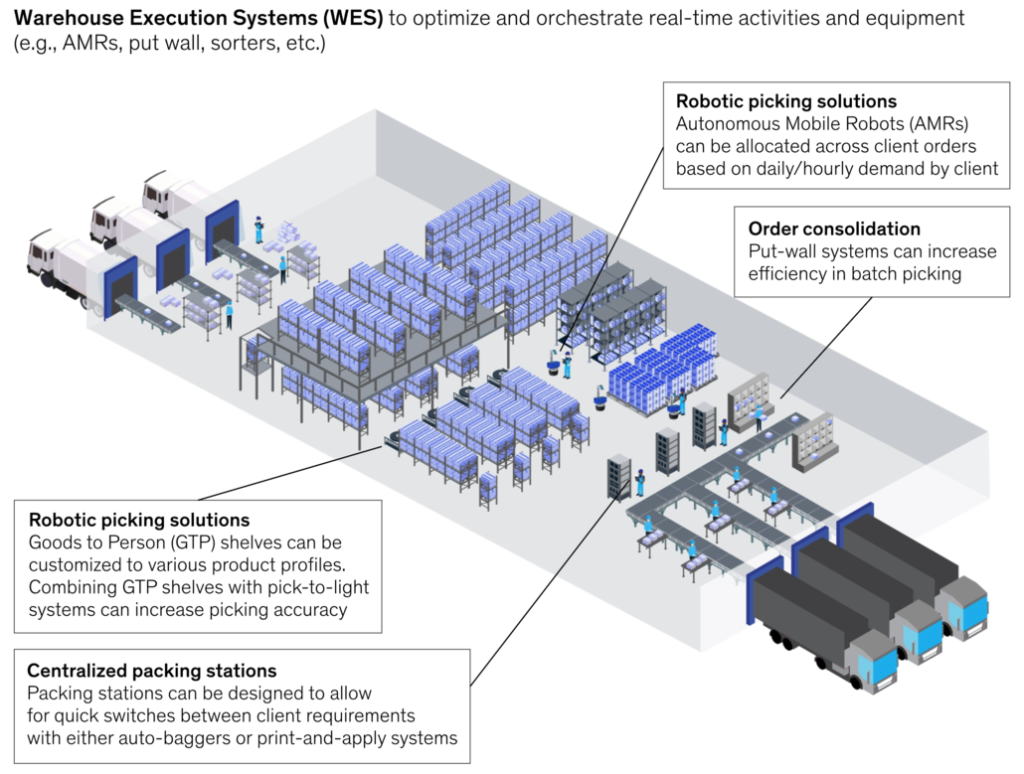
Source: The Promise and Challenges of Multi-Client Fulfillment for E-Commerce, McKinsey
การดำเนินการตามคำสั่งซื้อ มีตั้งแต่รูปแบบลูกค้ายรายเดียวโดยเฉพาะ ซึ่งจะปรับแต่งตามความต้องการของลูกค้า ไปจนถึงรูปแบบหลายลูกค้าที่ซึ่งเป็นที่นิยมโดยร้านค้าปลีกอิเล็กทรอนิกส์ขนาดใหญ่ รูปแบบการดำเนินการเติมเต็มแบบลูกค้าหลายรายอาจทำให้ 3PL สามารถแข่งขันในอีคอมเมิร์ซได้ สามารถถอดการเรียนร็ตรงนี้ได้จากวิธีที่ผู้ค้าปลีกทางอิเล็กทรอนิกส์รายใหญ่ใช้จัดระเบียบคลังสินค้าแบบหลายลูกค้า ซึ่งอาจนำไปใช้กับโมเดลแบบหลายไคลเอนต์ได้ อย่างเช่น การปรับใช้เทคโนโลยีและระบบอัตโนมัติในทุกที่ที่ทำได้ และการแชร์กระบวนการและทรัพยากรระหว่างลูกค้า ทำให้ประหยัดต้นทุนได้อย่างมาก แม้บริษัทขนาดเล็กขนาดเล็กอาจไม่เหมาะสมในเชิงโครงสร้างที่จะปรับใช้แนวทางนี้ แต่ประยุกต์ใช้แบบจำลองฯ เพียงบางส่วน ก็ส่งผลให้ต้นทุนลดลงอย่างมาก
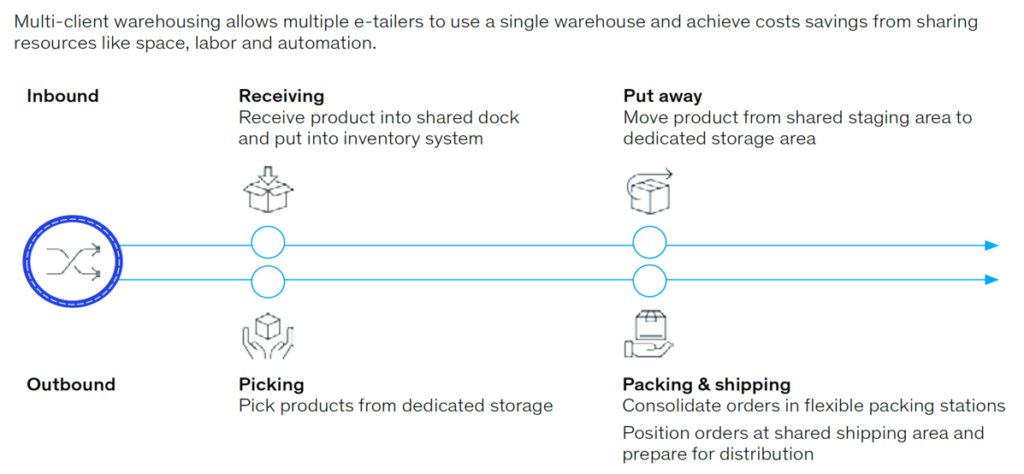
Product flow in the multi-client warehouse
Source: The Promise and Challenges of Multi-Client Fulfillment for E-Commerce, McKinsey
การดำเนินการเติมเต็มลูกค้าหลายราย สามารถสร้างมูลค่าให้กับร้านค้าปลีกอิเล็กทรอนิกส์ได้หลายช่องทาง ทั้งเป็นโอกาสในการเติบโตครั้งสำคัญสำหรับ 3PL การดำเนินการเติมเต็มฯ ในลักษณะนี้จำเป็นต้องมีสิ่งปลูกสร้างจำนวนมากในหลายพื้นที่ ใกล้ลูกค้า ทำให้ดำเนินการเติมเต็มฯ ได้ใกล้เคียงกับระยะเวลารอคอยที่ลดลงของลูกค้า จนสามารถแข่งขันกับการจัดส่งแบบสองวันและวันเดียวกันของค้าปลีกที่เป็นเจ้าตลาดได้ สามารถลดค่าใช้จ่ายของ e-tialer เนื่องจากสามารถแบ่งปันค่าใช้จ่ายต่างๆ เช่น แรงงาน ระบบอัตโนมัติ และอาคารสถานที่ร่วมกับ e-tailer รายอื่นได้ ให้ความยืดหยุ่นได้มากกว่าการดำเนินการแบบลูกค้ารายเดียว เนื่องจากหลีกเลี่ยงข้อผูกมัดระยะยาวกับ 3PL ลดต้นทุนตามหลัก economies of scale ซึ่งเป็นพื้นฐานอั้นสำคัญที่ทำให้ e-tailers เข้าถึงลูกค้าได้มากขึ้นเร็วขึ้นโดยไม่ต้องเพิ่มพื้นที่คลังหรือสิ่งปลูกสร้าง
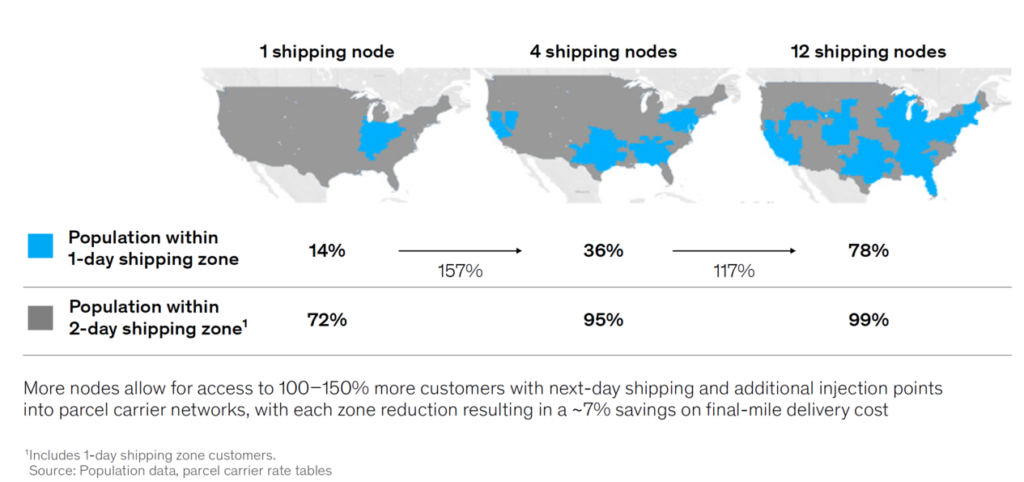
แนวคิดการเติมเต็มลูกค้าหลายราย ทำให้ 3PLs ประหยัดต้นทุน 7% ถึง 9% เมื่อเทียบกับการเติมเต็มแบบเดิม ต้นทุนที่ประหยดได้ดังกล่าว เกิดจากหลายปัจจัย ได้แก่ การบริหารโหลดงาน การปรับขนาดไซต์ การทำงานอัตโนมัติ และการประหยัดในขั้นตอนการส่งมอบระยะทางสุดท้าย จากการศึกษาของ McKinsey พบว่า ประมาณ 90% ของผู้เชี่ยวชาญด้านโลจิสติกส์เชื่อว่าปัจจุบัน e-fulfillment ทำให้เกิดกำไรมากขึ้น 5% ถึง 10% ซึ่งเป็นผลมาจากการประหยัดต้นทุนในจากดำเนินการเติมเต็มลูกค้าแบบหลายราย ในท้ายที่สุดสามารถเพิ่มผลกำไรจากอีคอมเมิร์ซได้สองถึงสามเท่า
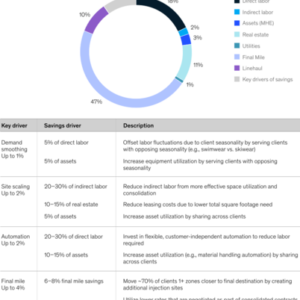
Multi-client fulfillment drives savings of 7-9% compared with dedicated fulfillment
Source: The Promise and Challenges of Multi-Client Fulfillment for E-Commerce, McKinsey
การเปลี่ยนจากรูปแบบที่รองรับลูกค้ารายเดียวมาเป็นรองรับลูกค้าหลายราย อาจนำมาซึ่งความท้าทายในเชิงพาณิชย์ ตัวอย่างเช่น ศูนย์เติมเต็มอาจจะไม่ทำงานจนถึงขีดความสามารถในทันที ประสิทธิภาพและความคุ้มทุนจะเกิด และ 3PL จะต้องปรับแต่งระบบงานคลังสินค้าและการดำเนินงานเพื่อใช้ทรัพยากรที่มีอยู่อย่างมีประสิทธิภาพอย่างเช่นพื้นที่และแรงงาน จะต้องมีทีมจัดการสินค้าคงคลังและเครื่องมือใหม่ๆ เพื่อจัดการกับความซับซ้อนที่เพิ่มขึ้นของสินค้าที่ปะปนกัน อีกด้วย
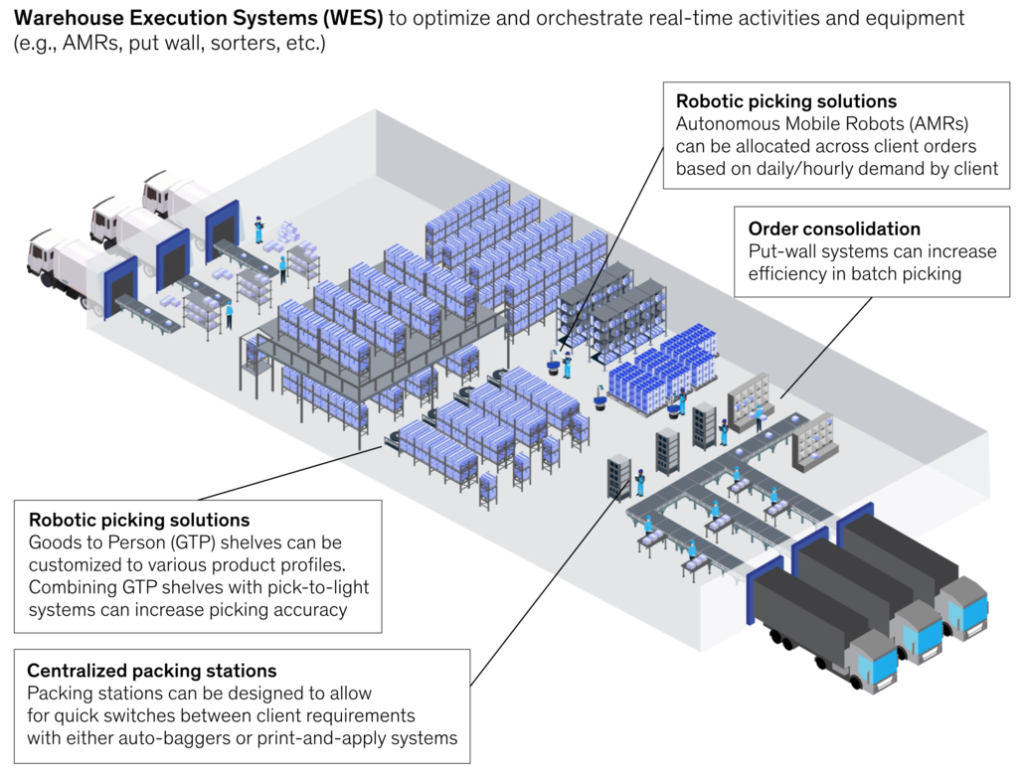
Source: The Promise and Challenges of Multi-Client Fulfillment for E-Commerce, McKinsey
โดยสรุปก็คือ แนวคิดการเติมเต็มแบบลูกค้าหลายรายเป็นโอกาสอันสำคัญที่ 3PL ที่จะใช้ประโยชน์จากกระแสการช็อปปิ้งออนไลน์ที่เฟื่องฟูในปัจจุบัน ในขณะที่เผชิญกับความท้าทายของต้นทุนที่เพิ่มขึ้น ความต้องการของลูกค้าที่ซับซ้อน และการแข่งขันที่สูงขึ้น แนวทางดังกล่าวนี้ สามารถให้บริการและรองรับลูกค้าได้มากขึ้นอย่างรวดเร็ว อีกทั้งยังเป็นแนวทางที่ใช้ทรัพยากรอย่างมีประสิทธิภาพสูงสุด ซึ่งจะช่วยลดต้นทุนและเพิ่มผลผลิต อย่างไรก็ตาม 3PL ที่ต้องการนำรูปแบบดังกล่าวนี้มาใช้จนเกิดผลสำเร็จ 3PL จำเป็นต้องเปลี่ยนความคิดและรูปแบบธุรกิจอย่างเป็นรูปธรรม ตัวอย่างเช่น โครงสร้างการค้าการประกอบการ ต้องสามารถรองรับค่าใช้จ่ายล่วงหน้า มีความพร้อมด้านอาคารสถานที่สิ่งปลูกสร้างอสังหาริมทรัพย์และความพร้อมในการใช้งานระบบอัตโนมัติ ซึ่งโดยปกติแล้วการเปลี่ยนแปลงรูปแบบการเติมเต็มลูกค้าดังที่กล่าวมาทั้งหมดนี้ จะมาพร้อมกับผลิตภัณฑ์บริการใหม่ๆ กลยุทธ์ด้านราคา ตลอดจนการปรับปรุงการดำเนินงานและกระบวนการต่างๆ
Article by: Asst. Prof. Suwan Juntiwasarakij, Ph.D., Senior Editor












